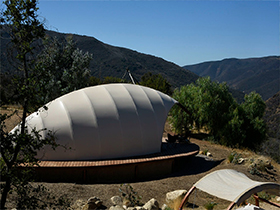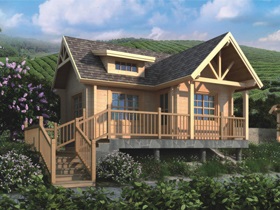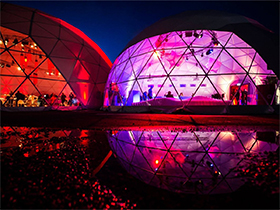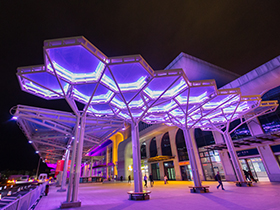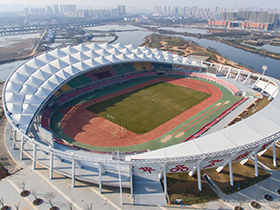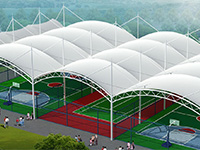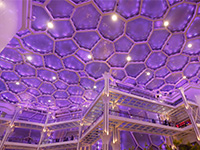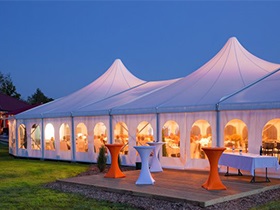Progetto e Produttore della Struttura della Membrana di Trazione Professionale
Con 10 anni di esperienza nel settore delle strutture a membrana tesa, abbiamo progettato, ingegnerizzato, prodotto e installato con successo migliaia di progetti di costruzione di membrane a tensione di alta qualità in 37 paesi in tutto il mondo. Le strutture in tessuto a trazione utilizzate come copertura / tettoia / ombra / vela / tendone per impianti sportivi, strutture di trasporto, strutture culturali, strutture paesaggistiche, strutture commerciali, tettoia per trattamento delle acque reflue, serbatoi di stoccaggio di biogas, strutture di membrane d'aria, hotel con struttura a membrana, cupole geodetiche ecc. La nostra struttura è conforme agli standard locali e internazionali relativi al carico di vento e neve. Non correremo mai rischi quando forniremo ai nostri clienti una struttura a membrana tesa che soddisfa i requisiti di carico del vento e della neve di ogni regione o paese.
-

Produttore professionale
Siamo specializzati nella fornitura di una gamma completa di servizi, dal concept design all'implementazione di progetti di strutture in tessuto.
-

Servizio di qualità
Offriamo un servizio rapido, di alta qualità ed entusiasta e la soddisfazione del cliente è la nostra priorità numero uno.
-
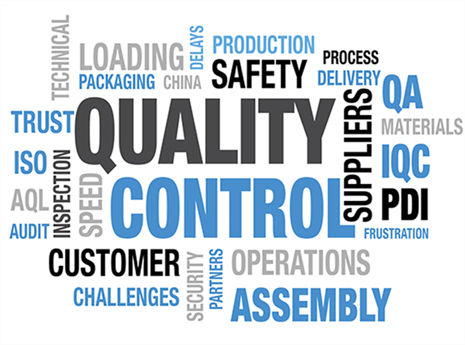
Visione aziendale
La qualità è il filo conduttore della nostra azienda
Fabbrica di Lavorazione dell'acciaio
La fabbrica di lavorazione delle strutture in acciaio copre un'area di 3.000 m2. Dispone di una tagliatrice a filo intersecante CNC, di macchine smussatrici per curvatubi e di un'officina di finitura con tornitura, fresatura, piallatura e perforazione. La capacità di lavorazione annuale della struttura in acciaio è di 10.000 tonnellate. Ha la qualifica di costruzione a tre livelli della struttura d'acciaio rilasciata dal dipartimento competente della costruzione dello stato.
Fabbrica di Tessuti
Lo stabilimento di lavorazione delle membrane tessili si estende su una superficie di 5.000 m2, con una capacità produttiva annua di 200.000 m2 di PTEF; una capacità produttiva annua di 100.000 m2 di ETFE; e una capacità di produzione annuale di 300.000 m2 di PVC / PVDF. Abbiamo la qualifica di progettazione e costruzione della struttura della membrana azione rilasciata da associazioni di categoria.
Centro notizie






Geodesic Dome Tents: A Visual Delight for Travelers Tensile Membrane Structures: Innovation, Aesthetics, and Performance What is a Tensile Fabric Structure? Why Load Analysis is Essential Informazioni Su BDiR Inc.
BDIR Stage Membrane Structures: Redefining Event Spaces with Innovation
BDIR specializes in cutting-edge stage membrane structures that transform events into unforgettable experiences. Designed for global clients, our solutions blend architectural elegance with engineering precision, creating iconic spaces for concerts, exhibitions, festivals, and corporate events.

-
Sleek & Functional Design: Customizable shapes and sizes to match any theme or branding.
-
Durable Materials: High-performance PVC or PTFE membranes ensure weather resistance, UV protection, and long-term reliability.
-
Rapid Installation: Engineered for quick setup and dismantling, ideal for time-sensitive events.
-
Sustainability: Eco-friendly materials and energy-efficient designs align with modern green standards.

Global Applications
From open-air music festivals in Europe to luxury product launches in the Middle East, BDIR structures adapt seamlessly to diverse climates and cultural needs. Our projects have elevated events worldwide, offering both visual impact and practical functionality.

Partner with BDIR
Elevate your next event with a stage that captivates. Contact BDIR to explore bespoke membrane structure solutions tailored to your vision.

















